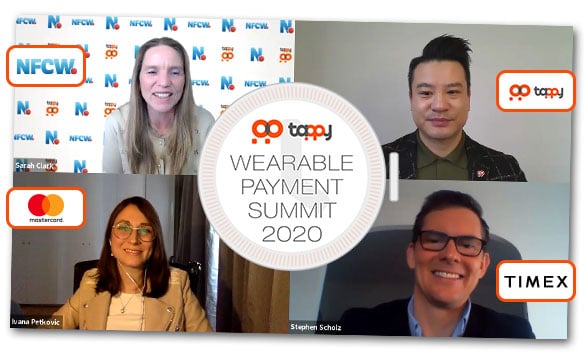
KNOWLEDGE CENTRE: Convenience, consumer choice, and the ability to use contactless payments for public transportation hold the key to driving the mass market adoption of wearable payments in urban environments, Timex, Mastercard and Tappy explain in a panel discussion which is now available to watch free of charge in the NFCW Knowledge Centre.
The discussion is part of the Wearable Payment Summit 2020 and focuses on the role of wearable payments in urban mobility and smart cities. NFCW’s editor, Sarah Clark, is joined for the session by:
- Wayne Leung, CEO of wearable payments innovator Tappy Technologies, in Toronto
- Stephen Scholz, senior director of product and marketing for digital watches and technology at Timex Group, in Connecticut
- Ivana Petkovic, director of wearable payments and IoT for Mastercard Europe, in Belgium
Timex Group has partnered with Tappy for the launch of Timex Pay later this year, Scholz explains during the discussion. Timex Pay will use Tappy’s wearable token service provider platform to let customers add their choice of payment card to a battery-free payment module that is neatly embedded into the strap of the company’s traditional, analog timepieces.
“The focus for the launch for us is our Timex brand, because of the brand awareness as well as the breadth of the portfolio and all of the different consumer groups that this brand can reach,” Scholz explains.
Timex Group is also planning to offer a range of watch straps that customers can use with their existing watches, he adds, and there are also plans to introduce payments capabilities across its range of watch brands.
Aspirational
“It’s on the roadmap for Timex across the group,” Scholz says. “We can slice it and dice it for all of our different consumers, whether it’s a young millennial, an urban consumer, whether it’s a more aspirational, luxury consumer, and then all the fashion brands in between like Guess and Nautica and Ted Baker.
“There’s really a valid use case for this technology within all of the brands in the group.”
That ability to offer consumers a wide range of choice will be a key driver of mass market adoption, Leung says, as it will mean that consumers will have the option of selecting the styles and the branding that they like.
“When you have more brands and more styles to choose from, you’re going to have mass adoption. And this mass adoption is coming from the usefulness, the convenience and the ease of being able to use these products in your favourite style,” he explains.
Security is also a key factor, along with the ability to leverage the work that has already been done to build a contactless acceptance infrastructure, Petkovic adds.
“When it comes to transit, what the evolution of digital payments shows us is that consumers really look for convenience, and definitely the convenience is there with wearable payments,” she says.
Convenience
“You wear your device and you don’t need to take it out. You don’t need to queue to buy your ticket. You just wear it and you tap in, you go, you pay for your journey. So definitely convenience is there and, most importantly, consumers are happy.”
During the session, the panellists also look in-depth at how wearable payments add value to busy urban consumers, explore the role of wearable payments beyond public transportation and examine the potential of secure, contactless wearables to deliver next-generation smart city experiences.
The full panel discussion is available for readers to watch free of charge in the NFCW Knowledge Centre.
Next: Visit the NFCW Expo to find new suppliers and solutions